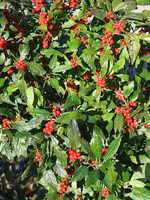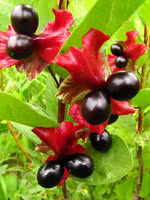Mon-Fri 9am - 5pm Mountain time
Winterberry vs Bracted Honeysuckle
Ilex verticillata
Lonicera involucrata
CUSTOM GROW
NOT AVAILABLE THIS SEASON - MIGHT RETURN
Winterberry is a small shrub that produces large quantities of bright red berries that remain on the plant through the fall and into the winter. Adding this shrub to your yard will give it a unique splash of color and attract birds, especially after the leaves drop.
Note: although the foliage is attractive on its own, you need at least one male plant near your female plants or they won't produce berries.
Bracted Honeysuckle is a shade loving shrub that is distinguishable from other honeysuckles by its square stem and pointed leaves. Native to most of North America, this honeysuckle is found along swamps, rivers, riparian zones and moist wooded areas.
If you have a erosion control project in mind, consider Bracted Honeysuckle.

